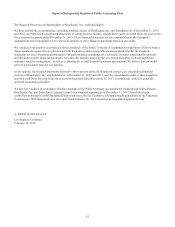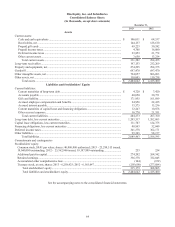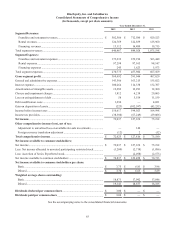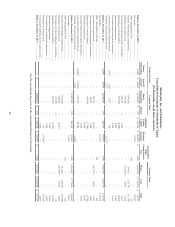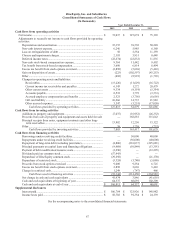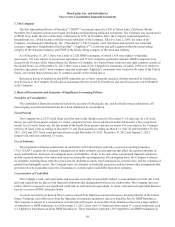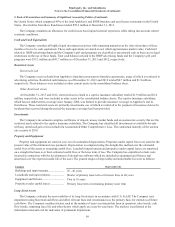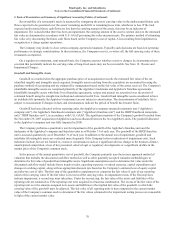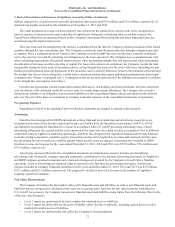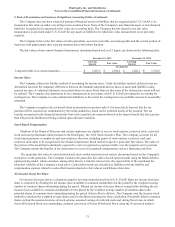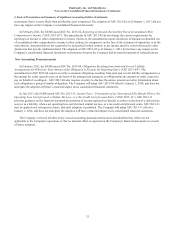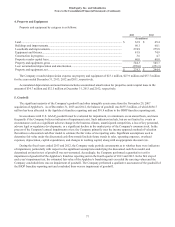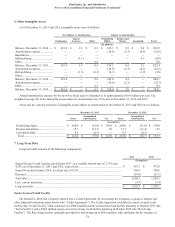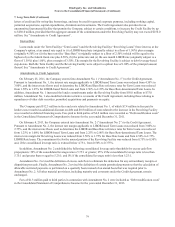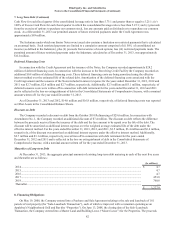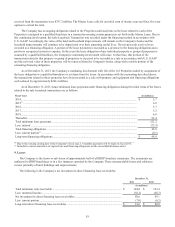IHOP 2013 Annual Report Download - page 94
Download and view the complete annual report
Please find page 94 of the 2013 IHOP annual report below. You can navigate through the pages in the report by either clicking on the pages listed below, or by using the keyword search tool below to find specific information within the annual report.
DineEquity, Inc. and Subsidiaries
Notes to the Consolidated Financial Statements (Continued)
2. Basis of Presentation and Summary of Significant Accounting Policies (Continued)
73
The Company does not have a material amount of financial assets or liabilities that are required under U.S. GAAP to be
measured at fair value on either a recurring or non-recurring basis. None of the Company's non-financial assets or non-financial
liabilities is required to be measured at fair value on a recurring basis. The Company has not elected to use fair value
measurement, as provided under U.S. GAAP, for any assets or liabilities for which fair value measurement is not presently
required.
The Company believes the fair values of cash equivalents, accounts receivable, accounts payable and the current portion of
long-term debt approximate their carrying amounts due to their short duration.
The fair values of non-current financial instruments, determined based on Level 2 inputs, are shown in the following table:
December 31, 2013 December 31, 2012
Carrying
Amount Fair Value Carrying
Amount Fair Value
(In millions)
Long-term debt, less current maturities............................... $ 1,203.5 $ 1,306.2 $ 1,202.1 $ 1,334.2
Income Taxes
The Company utilizes the liability method of accounting for income taxes. Under the liability method, deferred taxes are
determined based on the temporary differences between the financial statement and tax bases of assets and liabilities using
enacted tax rates. A valuation allowance is recorded when it is more likely than not that some of the deferred tax assets will not
be realized. The Company also determines its tax contingencies in accordance with U.S. GAAP governing the accounting for
contingencies. The Company records estimated tax liabilities to the extent the contingencies are probable and can be reasonably
estimated.
The Company recognizes the tax benefit from an uncertain tax position only if it is more likely than not that the tax
position will be sustained on examination by the taxing authorities, based on the technical merits of the position. The tax
benefits recognized in the financial statements from such a position are measured based on the largest benefit that has a greater
than fifty percent likelihood of being realized upon ultimate resolution.
Stock-Based Compensation
Members of the Board of Directors and certain employees are eligible to receive stock options, restricted stock, restricted
stock units and performance units pursuant to the DineEquity, Inc. 2011 Stock Incentive Plan. The Company accounts for all
stock-based payments to employees and non-employee directors, including grants of stock options, restricted stock and
restricted stock units to be recognized in the financial statements, based on their respective grant date fair values. The value of
the portion of the award that is ultimately expected to vest is recognized as expense ratably over the requisite service periods.
The Company reports the benefits of tax deductions in excess of recognized compensation cost as a financing cash flow.
The grant date fair value of restricted stock and stock-settled restricted stock units is determined based on the Company's
stock price on the grant date. The Company estimates the grant date fair value of stock option awards using the Black-Scholes
option pricing model, which considers, among other factors, a risk-free interest rate, the expected life of the award and the
historical volatility of the Company's stock price. Cash-settled awards are classified as liabilities with the liability and
compensation expense related to cash-settled awards adjusted to fair value at each balance sheet date.
Net Income (Loss) Per Share
Net income (loss) per share is calculated using the two-step method prescribed in U.S. GAAP. Basic net income (loss) per
share is computed by dividing the net income (loss) available to common stockholders for the period by the weighted average
number of common shares outstanding during the period. Diluted net income (loss) per share is computed by dividing the net
income (loss) available to common stockholders for the period by the weighted average number of common shares and
potential shares of common stock outstanding during the period if their effect is dilutive. The Company uses the treasury stock
method to calculate the weighted average shares used in the diluted earnings per share calculation. Potentially dilutive common
shares include the assumed exercise of stock options, assumed vesting of restricted stock and, during fiscal years in which
Series B Preferred Stock was outstanding, assumed conversion of Series B Preferred Stock using the if-converted method.


